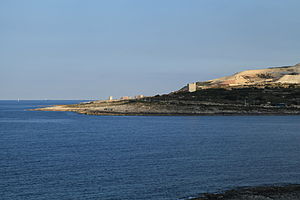De Redin towers
| De Redin Towers | |
|---|---|
| Various locations in Malta and Gozo | |

View of Naxxar's coastline, with three De Redin towers visible (Għallis, St. Mark's and Madliena Towers)
|
|
| Type | Coastal watchtowers |
| Site information | |
| Condition | 9 intact 2 in ruins 3 destroyed |
| Site history | |
| Built | 1658–1659 1661 |
| Built by | Order of Saint John |
| In use | 1658–1940s |
| Materials | Limestone |
| Battles/wars |
Siege of Malta (1798–1800) World War II |
The De Redin Towers (Maltese: Torrijiet ta' De Redin) are a series of small coastal watchtowers built in Malta by the Order of Saint John between 1658 and 1659. Thirteen towers were built around the coast of mainland Malta, nine of which still survive. A fourteenth tower was built on Gozo in 1661, and it is sometimes also considered to be one of the De Redin towers due to the similarities in design.
The Spanish knight Martin de Redin was elected Grand Master of the Order of St. John on 17 August 1657. In March 1658, he contributed 6428 scudi for the construction of 13 new watchtowers to strengthen the existing coastal defence system, which consisted mainly of the Wignacourt and Lascaris towers.
The design of the new towers was based on the Sciuta Tower, one of the Lascaris towers, which had been built in Wied iż-Żurrieq in 1638. Each tower had a square base with two floors, with a turret on the roof. The entrance was on the top floor, and was reached by a retractable ladder. The upper room was used as the living quarters for the garrison of four men, while the bottom room was used for storage. Two cannon were mounted on the roof of each tower.
Each tower also had two neighbouring towers in its line of sight, so that signals could be sent from one tower to another, in order to maintain a communication link between Gozo and the Grand Harbour. The signals consisted of smoke or cannon shots by day, or fire by night.
Construction of the first tower, located at Għajn Ħadid in Selmun, began in March 1658, and it was complete within two months. Twelve other towers were built within the following year, with the last tower being complete by July 1659.
...
Wikipedia
